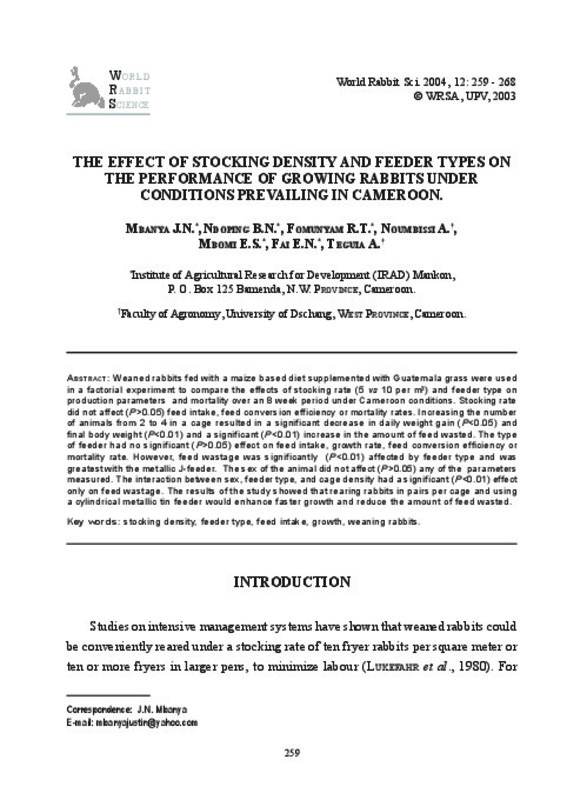JavaScript is disabled for your browser. Some features of this site may not work without it.
Buscar en RiuNet
Listar
Mi cuenta
Estadísticas
Ayuda RiuNet
Admin. UPV
The effect of stocking density and feeder types on the performance of growing rabbits under conditions prevailing in Cameroon
Mostrar el registro sencillo del ítem
Ficheros en el ítem
| dc.contributor.author | Mbanya, J. N.
|
|
| dc.contributor.author | Ndoping, B. N.
|
|
| dc.contributor.author | Fomunyam, R. T.
|
|
| dc.contributor.author | Noumbissi, A.
|
|
| dc.contributor.author | Mbomi, E.S.
|
|
| dc.contributor.author | Fai, E.N.
|
|
| dc.contributor.author | Teguia, A.
|
|
| dc.date.accessioned | 2011-02-14T10:38:23Z | |
| dc.date.available | 2011-02-14T10:38:23Z | |
| dc.date.issued | 2004 | |
| dc.identifier.issn | 1257-5011 | |
| dc.identifier.uri | http://hdl.handle.net/10251/9778 | |
| dc.description.abstract | [EN] Weaned rabbits fed with a maize based diet supplemented with Guatemala grass were used in a factorial experiment to compare the effects of stocking rate (5 vs 10 per m²) and feeder type on production parameters and mortality over an 8 week period under Cameroon conditions. Stocking rate did not affect (p>0.05) feed intake, feed conversion efficiency or mortality rates. Increasing the number of animals from 2 to 4 in a cage resulted in a significant decrease in daily weight gain (P<0.05) and final body weight (p<0.01) and a significant (P<0.01) increase in the amount of feed wasted. The type of feeder had no significant (P>0.05) effect on feed intake, growth rate, feed conversion efficiency or mortality rate. However, feed wastage was significantly (P<0.01) affected by feeder type and was greatest with the metallic J-feeder. The sex of the animal did not affect (P>0.05) any of the parameters measured. The interaction between sex, feeder type, and cage density had a significant (P<0.01) effect only on feed wastage. The results of the study showed that rearing rabbits in pairs per cage and using a cylindrical metallic tin feeder would enhance faster growth and reduce the amount of feed wasted. | es_ES |
| dc.description.sponsorship | The authors extend sincere gratitude to the Chief of Station IRAD Mankon for providing financial support for the study. They further appreciate the contribution of Mr. Divine Fomunyam, Mrs. Philisia Abudu and the rest of the support staff of the rabbit unit in the feeding, cleaning and follow up of the animals | |
| dc.language | Inglés | es_ES |
| dc.publisher | World Rabbit Science. ICTA. UPV | es_ES |
| dc.relation.ispartof | World Rabbit Science | |
| dc.rights | Reserva de todos los derechos | es_ES |
| dc.subject | Stocking density | es_ES |
| dc.subject | Feeder type | es_ES |
| dc.subject | Feed intake | es_ES |
| dc.subject | Growth | es_ES |
| dc.subject | Weaning rabbits | es_ES |
| dc.title | The effect of stocking density and feeder types on the performance of growing rabbits under conditions prevailing in Cameroon | es_ES |
| dc.type | Artículo | es_ES |
| dc.date.updated | 2011-02-14T10:16:28Z | |
| dc.identifier.doi | 10.4995/wrs.2004.567 | |
| dc.rights.accessRights | Abierto | es_ES |
| dc.description.bibliographicCitation | Mbanya, JN.; Ndoping, BN.; Fomunyam, RT.; Noumbissi, A.; Mbomi, E.; Fai, E.; Teguia, A. (2004). The effect of stocking density and feeder types on the performance of growing rabbits under conditions prevailing in Cameroon. World Rabbit Science. 12(4):259-268. https://doi.org/10.4995/wrs.2004.567 | es_ES |
| dc.description.accrualMethod | SWORD | es_ES |
| dc.relation.publisherversion | https://doi.org/10.4995/wrs.2004.567 | |
| dc.description.upvformatpinicio | 259 | |
| dc.description.upvformatpfin | 268 | |
| dc.description.volume | 12 | |
| dc.description.issue | 4 | |
| dc.identifier.eissn | 1989-8886 | es_ES |
| dc.contributor.funder | Institut de Recherche Agronomique de Développement, Camerún |








